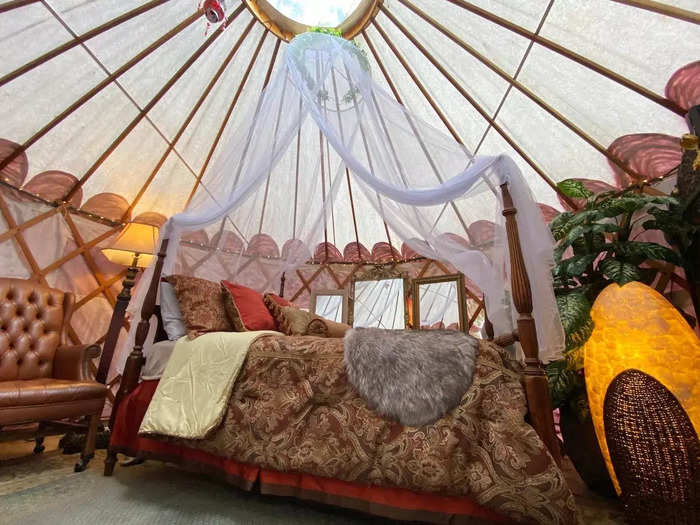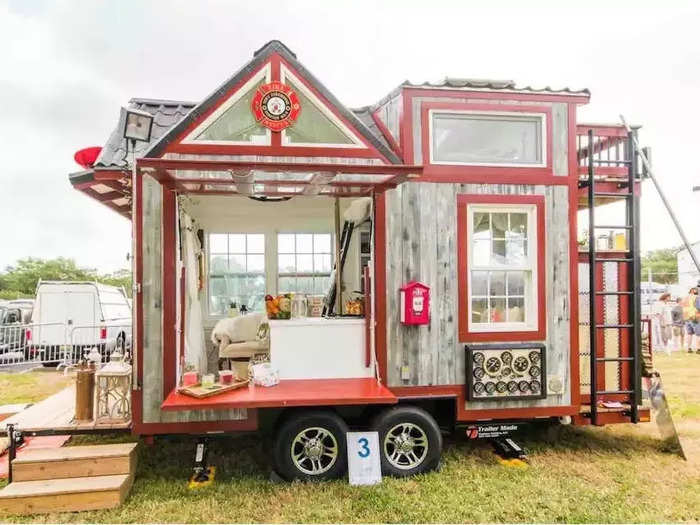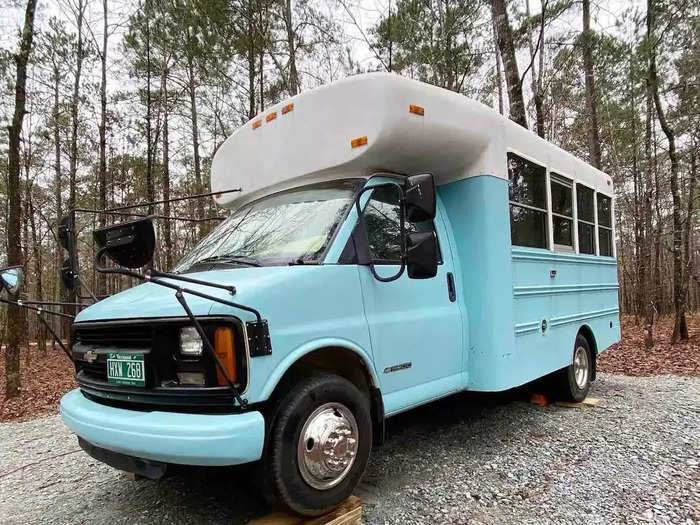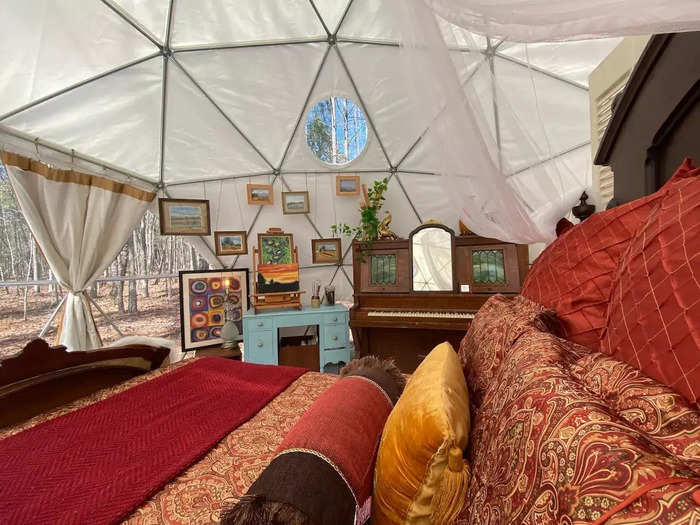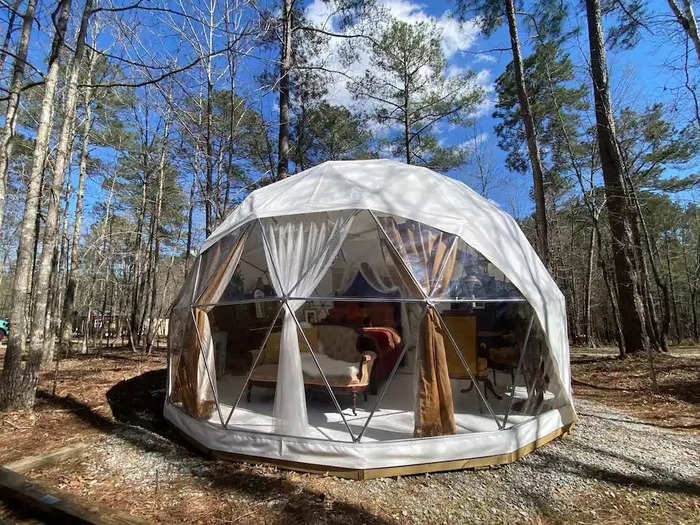One of the geodesic domes that the Kernohans host short-term guests in.Courtesy of the Kernohans
- Georgia couple John and Fin Kernohan welcome guests to unique properties that brought in $6,000 last month in revenue, they say.
- Managing unusual properties creates unique challenges like fighting the elements and managing guest expectations.
In 2020, John and Fin Kernohan turned their love of tiny homes into a full-fledged portfolio of seven unique rental properties spread over 16.2 acres near Georgia's Lake Oconee.
The couple still live full-time on-site in their 300-square-foot home, which they built in 2011, and welcome visitors year-round to a variety of unusual short-stays, including two cabin-esque tiny homes, two geodesic domes, a yurt, a tiny home "firehouse," and a converted school bus.
According to the Kernohans, between 40 to 60 guests visit the campgrounds each month, where only adults are allowed. In November, the couple generated $6,000 in revenue through travelers from Airbnb and the vacation site Glamping Hub, which Insider verified through records they provided.
Competition among Airbnb hosts has increased as short-term rental supply reaches record highs. Offering a distinct travel experience with a unique abode is one way to stand out and is even boosted by Airbnb's recent changes to their homepage.
John breaks down tips for hosts interested in managing out-of-the box properties, from keeping structures stable to informing guests they don't have a traditional toilet.
1. Don't ignore moisture when you're braving the elements
Inside the Kernohan's glamping yurt in the Georgia wilderness. Courtesy of the the Kernohans
While these unique structures may be furnished to look like real homes, it's important to remember they are interacting with the elements differently, says John.
To prevent a "damp" smell in the structure, the Kernohans run dehumidifiers between guest stays to keep the yurts and domes dry.
"You don't want someone stepping in a yurt and it smelling like an old tent. You want it smelling nice and fresh," John said.
Perishable items are also more likely to go stale, even if they're sealed in metal or ceramic containers. John says those hospitality touches that go a long way with guests, like providing fully-stocked coffee service with sugar and artificial sweeteners, require more supplies in non-traditional structures.
2. Constantly check unique structures to make sure they're level
The tiny home "firehouse" that the Kernohans rent out to travelers. Courtesy of the Kernohans
For these unusual properties, it's important to keep things in balance.
"If these houses aren't level, a guest will tell you," John told Insider.
John says some early guests in the converted school bus said they felt like they were "leaning downward" in the bed and woke up feeling "blood rushing." John went in to check with a leveler and discovered the bus was sitting on a small incline that was making a big difference.
So the Kernohans created a makeshift lift out of 2-by-10 boards and the front tires now sit 18 inches higher than the back tires for guest comfort.
John regularly checks the levels on all his properties, making the rounds monthly. He'll check the windowsill and the center of the floor for each structure and make the necessary adjustments accordingly.
3. Remember to set guest expectations for unorthodox amenities
The Kernohan's converted bus, which they decorated with a "French farmhouse" theme. Courtesy of the Kernohans
Guests might be excited for the adventure of staying in an atypical property, but they might also need a reality check.
John says out of hundreds of five-star reviews, their most negative feedback came from a guest who was expecting a modern air conditioner in her yurt made of canvas.
Clearly and repeatedly communicating what the structures provide early on will prevent any bitter guests, John says.
The correct framing for the experience can also go a long way. The Kernohan's geodesic domes, which look like half-sphere tents, come with "dry toilets," which means human materials are collected rather than flushed.
John says he's learned to rebrand them not as a difficulty, but rather a "toilet of convenience." There is a community house on site with running water, but John now emphasizes that the dry toilets are for the guest's comfort, in case they don't want to travel to the community house in the middle of the night.
"Guests realize, 'Oh, you're doing something for me to make my stay more convenient,' instead of 'Oh, what a pain in the butt,'" John explained to Insider.
4. Don't ignore the indoors
Inside one of the geodesic domes decorated to be an "art studio." Courtesy of the Kernohans
Guests will certainly be drawn to unique properties for their exteriors, but be careful not to skimp-out on the interiors, John cautions.
Fin chose to outfit their rental tiny homes with themes to give guests a fully immersive experience. One is inspired by J.R.R. Tolkein's "The Hobbit" and filled with vines, branches, and antique pottery to create an earthy environment. The other is inspired by Moroccan decor, complete with a 200-pound chandelier from 1937.
Even the converted school bus has a "French farmhouse" theme with white-lace decorations.
Guests are already seeking out a unique experience, so the Kernohans believe in investing all-the-way to guarantee positive reviews and return stays.
5. Don't be afraid of co-hosting first
One of the geodesic domes on the Kernohan's property. Courtesy of the Kernohans
For new hosts still wary of taking the leap into the business, the Kernohans recommend partnering up to share responsibility and learn the quirks of unique properties.
Currently, their converted school bus is actually a co-hosting partnership with a University of Georgia student whose mother originally owned the bus for her daycare. The student used to park the vehicle in front of his fraternity, but was eventually banned from doing so. In searching for a place to store it, he connected with Finn over Airbnb.
She eventually converted the bus into a rental and now the couple split revenue for the rental 70/30 with the student.
John believes a similar partnership could help get an aspiring host's feet wet, as they start to understand the logistics of maintenance and guest management.

